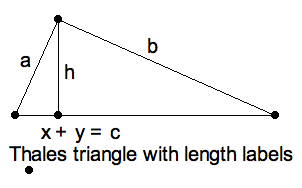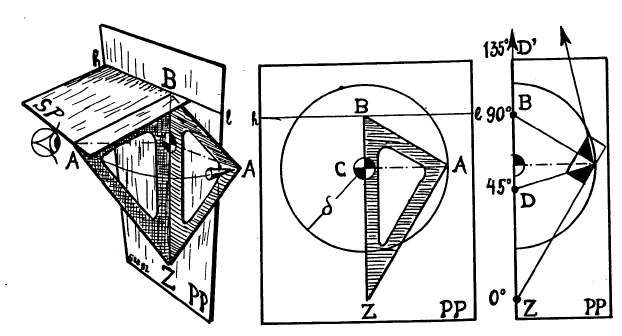First, a brief vocabulary lesson. In the real 3D world, the horizon is an
apparent line where a flat earth meets the sky. The zenith is the direction
we mean when we say "straight up". We may generalize to 3D geometry as follows.
The horizon of a plane is the pencil of all planes parallel to a given plane.
In Kepler’s terms, it it the ideal line corresponding to the plane. The
zenith of a plane is the ideal point corresponding to the pencil of
parallel lines that are perpendicular to the plane.
With Alberti we transfer these concept to a picture plane or canvas,
relative to an eye in space, whose (perpendicular) distance to
the canvas is the focal distance. The painter draws a horizontal line
on the canvas where she sees the horizon of the ground plane. The point
nearest to the eye on the canvas, hence where the perpendicular from the
eye to the canvas meets that plane, is called the eye point or
orthocenter.
We should be careful to understand the difference between the eye, which
is a point in space not on the canvas, and the eye point, which is a
point on the canvas. Also, we anticipate a supremely important propery of
this point by calling it the orthocenter, since that terms properly means
the point where the altitudes of a triangle meet.
The zenith point on the canvas is where the line perpendicular
to the ground plane pierces the canvas. If the canvas happens to be
vertical (a window pane, for example) then the zenith line is parallel
to the canvas. In that case, the zenith point is an ideal point in
the canvas.
The vanishing point of a line is the point in the canvas that a
the eye ray for the line meets the canvas. The eye ray of a
line in space is the line through the eye which is parallel to it.
In effect, it is where the one-eyed painter sees the line meet the
plane at infinity. Horizontal lines all vanish on a point on the
hozion line.
Finally, when the context makes it clear that we’re talking about the
picture of the horizon, eye, and zenith in the canvas, we will be
sloppy and say things like "two parallel lines meet at their
common vanishing point".
Around -600, Thales of Miletus collected a number of geometrical
theorems and also gave something like proofs for them. He is considered
to be the founder of Greek mathematics as a deductive science, based on
logic rather than miscellaneous observation. One of these says that a
triangle inscribed in a semicircle, with the diameter for a side, must
be a right triangle. Later, geometers noticed that dropping the altitude
from the right angle to the hypotenuse divided the right triangle into
two additional similar right triangles. Labeled as shown in the figure,
$ \triangle abc ~ \triangle xha ~ \triangle hyb $, and in that
order: short - long - hypotenuse.
Pythagoras' Theorem
From $ \frac{shrt}{hyp} = \frac{x}{a} = \frac{a}{c} $ and
the analogous comparison
$ \frac{long}{hyp} = \frac{y}{b} = \frac{b}{c} $ we have
|
$ xc = a^2 $ |
|
|
$ yc = b^2 $ |
|
|
$ c^2 = (x+Y)c = a^2 + b^2 $ |
|
Geometrical Mean
But for our present purposes, we want another comparison,
$ \frac{shrt}{long} = \frac{x}{h} = \frac{h}{y} $ ,
from which we see that $ h^2 = xy $ or, more interesting,
$ h = \sqrt{xy} $. For the Greeks, a segment $ h $
is the geometric mean of two segments $ x, y $ means that
$ \frac{x}{h}=\frac{h}{y} $. Today we say its the square-root
of the product.
Thales' triangle, or equivalently, the geometric mean, reappears
repeatedly in the art of perspective drawing. We present three
examples:
-
(1) Given the eye point (orthocenter), focal distance, and the horizon line,
find the corresponding zenith point.
-
(2) Given a convex quadrilateral in a plane. From where in space (eye and
focal distance) does this "look square".
-
(3) Complete the drawing of a cube, starting from the three vanishing lines
(horizons) of its faces, and a line segment representing one edge.
Horizon and Zenith
To solve the horizon-zenith problem, let’s analyze the situation from a
third-party view (left detail in the figure.).
A right triangle, $ \triangle BAZ $,
has been placed between picture plane, $ PP $ and eye of the
observer:
-
The hypotenuse is in the picture plane;
-
the apex of the triangle is at the eye of the perspectivist;
-
and one leg $ AB $ is in the sight plane $ SP $ ;
to the given horizon line $ h\ell $;
-
the altitude $ AC $ of the right triangle connects the eye
to the nearest point $ C $ on $ PP $;
-
the length of the altitude is the focal distance, $ \delta $
In the same detail, we lay this right triangle into the picture plane
by rotating it about the hypotenuse. The middle details is a view of
the canvas, as the artist is sees the picture plane. The interior of
the circle centered at $ C $ of radius $ \delta $
corresponds to a $ 90^\circ $ visual cone from the eye point.
Artists try to put most of their important details into this disc because
objects have less perspective distortion there than outside the disk.
Now, if we consider the sight plane $ SP $ a "horizontal", i.e.
parallel to the ground plane, then the line $ (AZ) $, being
"vertical", points to the "zenith", which is directly overhead. This
line pierces the canvas at $ Z $, and so we call $ Z $
zenith point corresponding to the given horizon line.
To synthesize this construction in a picture plane, rotate the triangle about
its hypotenuse. For now I shall assume that the focal disc is given,
and tell you later how to determine it from other clues in a given picture.
For any horizon line $h$, erect a right triangle with one acute
angle at $ B $, the foot of the perpendicular from the orthocenter
to the horizon. The apex $ A $ is on the focal circle.
The other end of the hypotenuse is the zenith point for $ h $ .
The principal use of the zenith point is to draw vertical lines in
perspecive:
Incidentally, we can use this right triangle to find the vanishing points
on $ (BZ) $ of lines that are inclined at other angles to the
vertical, such as the $ 45^\circ $ point $ D $
and the $ 135^\circ $ point $ D' $ (right detail).
These two points are significant because they correspond to vanishing
points for diagonals of a square in space whose sides vanish at $ B $
and $ Z $. We will meet such diagonal points again in subsequent
constructions.
Exercises
We close this section by posing some problems. We have seen above that
given $ C, \delta, h $ how to find $ Z $. To show that you
understand, also show how to find
-
$ C $, given $ \delta, h, Z $
-
$ \delta $, given $ h, Z, C $
-
$ h $, given $ C, \delta, Z $
by describing the construction. For a solution using a geometry drawing
tool, like KSEG, GEX, GSP, Geogebra etc, create a single file with four
labelled figures (use d for $\delta$, and the unknown in
a different color than the other labels.
For a solution using ruler and straightedge, indicate the order in
which features are constructed using subscripts. In each case, the
given items receive subscript 0.

